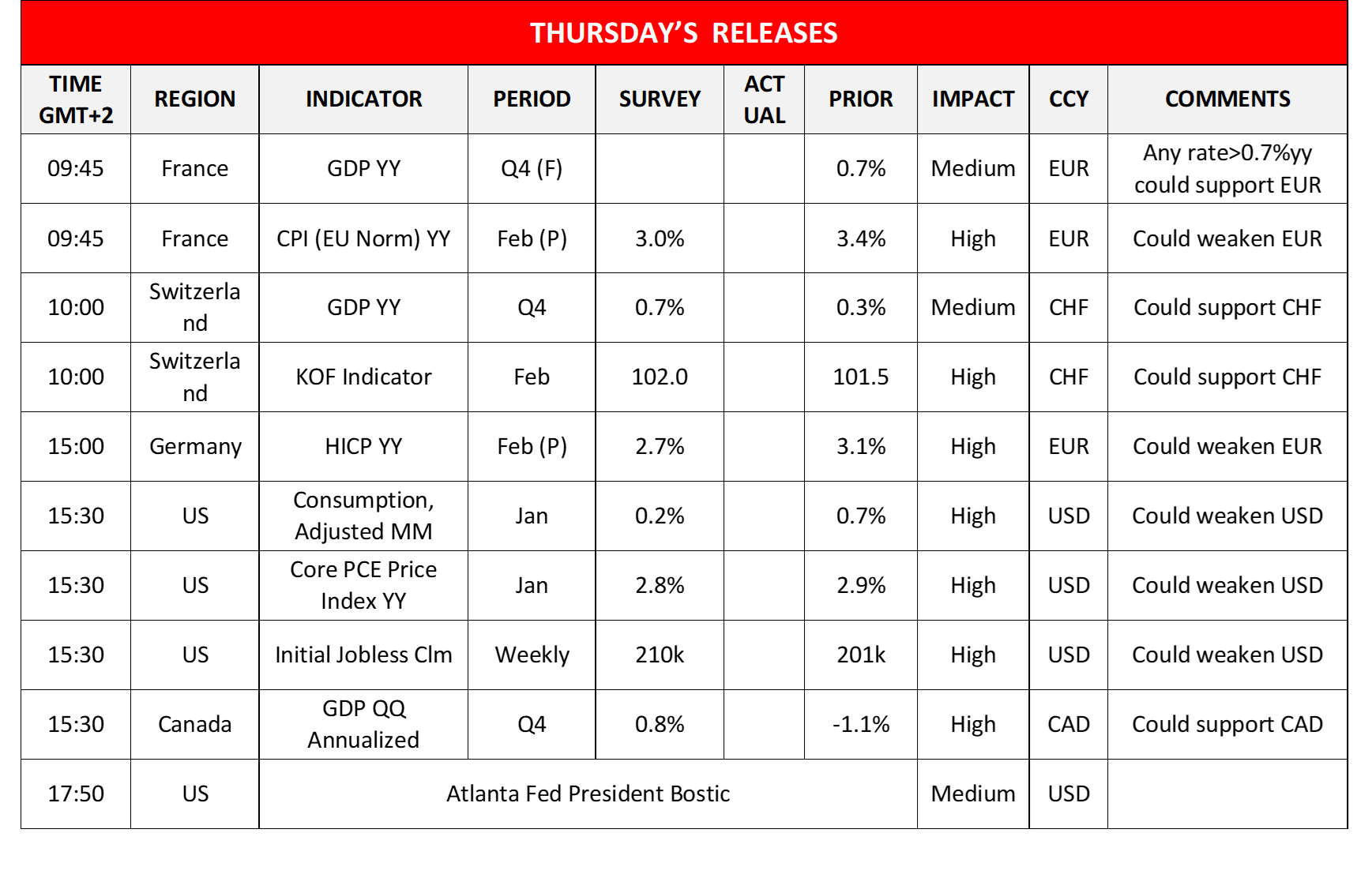The USD remained relatively unchanged against its counterparts yesterday despite the 2nd estimate of the GDP rate for Q4 23 ticking down and today attention turns towards the release of January’s US Core PCE Price Index, the Fed’s favorite inflation measure. The rate is expected to slow down on a year-on-year level, implying that inflationary pressures continue to ease in the US economy which in turn may add more pressure on the Fed to start cutting rates earlier, thus weakening the USD. On the flip side, the month-on-month rate is expected to accelerate implying that inflationary pressures are still simmering under the surface which may enhance the determination of the bank to keep rates high for longer and support the USD.
Across the Atlantic EUR traders are expected to keep a close eye on the release of France’s and Germany’s preliminary HICP rates for February. The rates are expected to show a deceleration if compared to January’s final rate and if actually so, may weigh on the common currency as they will be sending a message to ECB that it may be allowed to start earlier rate cuts.
EUR/USD maintained its sideways motion yesterday between the 1.0740 (S1) support line and the 1.0890 (R1) resistance line. We maintain our bias for the sideways motion to continue given also that the RSI indicator continues to run along the reading of 50 implying a rather indecisive market while at the same time, the Bollinger bands seem to have flattened out which may allow the sideways motion to be continued. Yet should buyers take charge of the pair’s direction, we may see EUR/USD breaking the 1.0890 (R1) resistance line and aiming for the 1.1010 (R2) resistance level. Should a selling interest be expressed by the market we may see EUR/USD breaking the 1.0740 (S1) support lien and aim for the 1.0615 (S2) support level.
Also, we would note the strengthening of JPY during today’s Asian session which was caused by BoJ policymaker Hajime Takata as he stated that BoJ’s inflation target has finally come into sight. The comment tends to enhance market expectations for a possible rate hike in April, ending BoJ’s decades-long negative interest rate and could keep JPY supported on a monetary level. BOJ’s intentions seem to have become the true catalyst behind JPY’s direction today.
USD/JPY seems to be escaping its sideways motion by breaking the 150.00 (R1) support line, now turned to resistance. Given also that the RSI indicator has dropped nearing the reading of 30, implying a build-up of a bearish sentiment among market participants for the pair, we switch our sideways bias in favor of a bearish outlook for the pair. Should the bears maintain control over the pair we may see it aiming if not breaching the 148.55 (S1) support line, thus paving the way for the 146.30 (S2) support base. For a bullish outlook, we set the prerequisites quite high, as we would require the pair to break the 150.00 (R1) resistance line and actively aim if not breach the 151.85 (R2) resistance hurdle.
Last but not least we note the release of China’s manufacturing PMI figures for February during tomorrow’s Asian session which is expected to show that Chinese factories are still struggling to keep economic activity afloat and if actually so, could turn the market sentiment a shade more cautious weighing on riskier assets.
Autres faits marquants de la journée :
Today in the European session, we note the release of France’s final GDP rate for Q4 while from Switzerland we get the GDP rate for Q4 and February’s KOF indicator. In the American session, we note from the US the release of January’s consumption rate and from Canada we get Q4’s GDP rate and New Zealand’s January building consents. On the monetary front, we note the speeches of Atlanta Fed President Bostic, Chicago Fed President Goolsbee and Cleveland Fed President Mester. During tomorrow’s Asian session, RBNZ Governor Orr is scheduled to speak.
Graphique de l’USD/JPY H4

Support: 148.55 (S1), 146.30 (S2), 144.35 (S3)
Resistance: 150.00 (R1), 151.85 (R2), 154.00 (R3)
Graphique de l’EUR/USD H4

Support: 1.0740 (S1), 1.0615 (S2), 1.0455 (S3)
Resistance: 1.0890 (R1), 1.1010 (R2), 1.1135 (R3)




Si vous avez des questions d'ordre général ou des commentaires concernant cet article, veuillez envoyer un email directement à notre équipe de recherche à l'adresse research_team@ironfx.com
Avertissement :
Ces informations ne doivent pas être considérées comme un conseil ou une recommandation d'investissement, mais uniquement comme une communication marketing. IronFX n'est pas responsable des données ou informations fournies par des tiers référencés, ou en lien hypertexte, dans cette communication.













